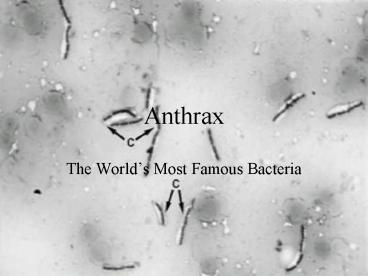Anthrax - PowerPoint PPT Presentation
1 / 17
Title:
Anthrax
Description:
... forms include ( 1 ) cutaneous anthrax ,from handling infected ... Cutaneous Anthrax. Cutaneous anthrax usually occurs through contamination of a ... Cutaneous ... – PowerPoint PPT presentation
Number of Views:110
Avg rating:3.0/5.0
Title: Anthrax
1
Anthrax
- The Worlds Most Famous Bacteria
2
History
- Anthrax has afflicted humans throughout recorded
history. The fifth and sixth plagues of Egypt
described in Exodus are widely believed to have
been anthrax. The disease was featured in the
writings of Virgil in 25 BC and was familiar in
medieval times as the Black Bane. It was from
studies on anthrax that Koch established his
famous postulates in 1876, and vaccines against
anthrax the best known being that of Pasteur
(1881)were among the first bacterial vaccines
developed.
3
What is it?
- Anthrax is caused by Bacillus anthracis.
- Bacillus species are rod-shaped,
endospore-forming aerobic or facultatively
anaerobic - The spores are resistant to heat, cold,
radiation, desiccation, and disinfectants.
Bacillus anthracis needs oxygen to sporulate
this constraint has important consequences for
epidemiology and control. In vivo, B anthracis
produces a polypeptide (polyglutamic acid)
capsule that protects it from phagocytosis.
4
How Can You Get It?
- Humans acquire the disease directly from contact
with infected herbivores or indirectly via their
products. The clinical forms include ( 1 )
cutaneous anthrax ,from handling infected
material (this accounts for more than 95 percent
of cases) (2) intestinal anthrax, from eating
infected meat and (3) pulmonary anthrax, from
inhaling spore-laden dust.
5
Cutaneous Anthrax
- Cutaneous anthrax usually occurs through
contamination of a cut or abrasion, although in
some countries biting flies may also transmit the
disease. After a 2- to 3-day incubation period, a
small pimple or papule appears at the inoculation
site. A surrounding ring of vesicles develops.
6
Cutaneous Anthrax
- Over the next few days, the central papule
ulcerates, dries, and blackens to form the
characteristic eschar .The lesion is painless and
is surrounded by marked edema that may extend for
some distance. Pus and pain appear only if the
lesion becomes infected by a pyogenic organism.
7
Cutaneous Anthrax
- In most cases the disease remains limited to the
initial lesion and resolves spontaneously. The
main dangers are that a lesion on the face or
neck may swell to occlude the airway or may give
rise to secondary meningitis. Approximately 20
percent of untreated cases of cutaneous anthrax
progress to fatal septicemia.
8
Cutaneous Anthrax
9
Cutaneous Anthrax
10
Cutaneous Anthrax
11
Gastrointestinal Anthrax
- Gastrointestinal and pulmonary anthrax are both
more dangerous than the cutaneous form because
they are usually identified too late for
treatment to be effective. - If the spores enter a lesion in the
gastrointestinal mucosa, they germinate and are
taken into the bloodstream and lymphatics,
finally producing systemic anthrax, which is
usually fatal.
12
Symptoms
- Intestinal The intestinal disease form of
anthrax may follow the consumption of
contaminated meat and is characterized by an
acute inflammation of the intestinal tract.
Initial signs of nausea, loss of appetite,
vomiting, fever are followed by abdominal pain,
vomiting of blood, and severe diarrhea.
Intestinal anthrax results in death in 25 to 60
of cases.
13
Pulmonary Anthrax
- inhaling anthrax spores from contaminated animal
products. In pulmonary anthrax, inhaled spores
are transported by alveolar macrophages to the
mediastinal lymph nodes, where they germinate and
multiply to initiate systemic disease. - Pulmonary Anthrax is usually fatal.
14
Pulmonary Anthrax
- Initial symptoms may resemble a common cold.
After several days, the symptoms may progress to
severe breathing problems and shock. Inhalation
anthrax is usually fatal.
15
Treatment
- Doctors can prescribe effective antibiotics,
Anthrax is readily treated with penicillin,
tetracycline, chloramphenicol, gentamicin, or
erythromycin. To be effective, treatment should
be initiated early. If left untreated, the
disease can be fatal.
16
Anthrax as a Biological Warfare Agent
- Anthrax is the preferred biological warfare agent
because - It is highly lethal.
- 100 million lethal doses per gram of anthrax
material (100,000 times deadlier than the
deadliest chemical warfare agent). - Silent, invisible killer.
- Inhalational anthrax is virtually always fatal.
17
Anthrax as a Biological Warfare Agent
- There are low barriers to production.
- Low cost of producing the anthrax material.
- Not high-technology. Knowledge is widely
available. - Easy to produce in large quantities.
- It is easy to weaponize.
- It is extremely stable. It can be stored almost
indefinitely as a dry powder. - It can be loaded, in a freeze-dried condition, in
munitions or disseminated as an aerosol with
crude sprayers.































